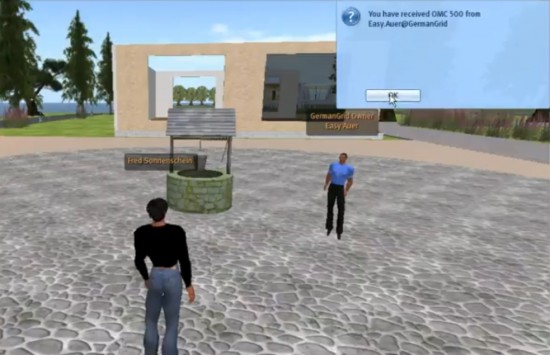Germany’s Grid4Us and GermanGrid launched in-world money systems yesterday, using the VirWox virtual payment system. The virtual money — Open Metaverse Currency — is fully convertible with US Dollars, Euros and other real world currencies, as well as with Linden Dollars.
Unlike previous attempts to set up currencies for in-world purchases, the OMC is backed by an established game currency company. Another major difference is that the currency acts the same way that Linden Dollars do in Second Life — the user balance shows in the browser, and the pay menu options are available for in-world item purchases or land rentals. One avatar can even give money to another avatar, just as in Second Life.

In addition, the currency works with hypergrid teleports. In order to access the currency, users need to link their Grid4Us or GermanGrid avatars by clicking on an in-world service kiosk. Then they can teleport to other grids and use the money there as well.

Grid4Us owner and manager Markus Maué (also known as “Hallow Palmer”) said that it took four months to get the system working and secure.
And although only two grids currently use the system, he said, other grids can easily sign up. They first need to contact VirWoX to get approval. Then the grid owner is set up with a master account, and gets a file to download into their OpenSim folder.
“Not every small grid gets to use OMC,” said Maué– VirWoX has to confirm that the grid is run by a reputable operator and is safe. “If it’s okay, there’s only on DLL to put in the binary folder — and it works.”
VirWoX does not charge any fees for the transactions, and grids register for free as well. VirWoX makes it money through the spread of the currency exchange conversion, Maué said.
The benefits for merchants are significant, since they can now use the exact same payment mechanisms that they would in Second Life.
“You can use normal money events, and the normal scripts from Second Life,” he said. “And your browser will show the balance at the top right. It works just like the Linden Dollar.”
The difference is that the payments are not limited to just one grid.
“If you run a business in one of those [supported] grids, you can receive OMC from users all around the hypergrid,” VirWoX said in a statement.
The exchange rate is currently about the same as that of the Linden Dollar — about 280 OMC to US$1.
“It’s a big step,” said Maué . “We hope to have more grids that start this over time.”
V$ and G$
Multi-grid OpenSim merchants have three other options besides OMC.
The most common is to use PayPal or PayPal Micropayments, with the buyer visiting the PayPal Web page to make the purchase through either their existing PayPal account or with a credit card. However, in-world delivery of items is tricky, and may require manual intervention or server-side software.
The oldest OpenSim currency is V$, backed by Dutch developer Arnout Saedt, also known as “ Arnout Sequent†in Second Life and on the OpenSim platforms. Saedt’s Virtual Wallet system is personally backed by Saedt himself, and requires both the buyers and the seller to have Second Life accounts, and deposit Linden Dollars into their Virtual Wallets. ATMs located in Second Life and on several OpenSim grids allow users to link multiple OpenSim avatars to a single Virtual Wallet account. Vendors have to use special-purpose Virtual Wallet vendors to sell their goods. Saedt limits the distribution of vendors to pre-approved grid, but there is no charge for payments or currency conversions.
The other multi-grid alternative is Cyber Coin Bank‘s G$, currently available on several grids, including Second Life, Avatar Hangout, AnSky, OSGrid, Segarra Estates, and Meta7. There is also a private casino using the currency, Hedonism Resort.
According to Cyber Coin Bank founder Frank Corsi, his company will not guarantee the convertibility of this currency. Instead, in-world third-parties known as “banks” will handle the currency transfer. Neither Cyber Coin Bank nor the “banks” affiliated with the platform are registered as actual banks, however, and there is no guarantee that a “bank” will be around when a user decides to cash out his or her account.
Like Virtual Wallet, several avatar names can be linked to a single account. Unlike some of the other platforms, Corsi said that his system helps protect against in-world fraud.
“Merchants that want to have a higher limit, I make them pay a reserve of G$,” Corsi said. “We use the reserve money as an insurance fund to help cover anybody who was ripped off. If anybody gets ripped off, or scammed, I will refund them back any money they lost. Linden Labs won’t get involved in a lot of the misuse. We will step in and help mediate for people.”
The system already has around 3,000 accounts, with more than 7,000 registered avatar names. It works with hypergrid teleports, he added.
“We’ve done a lot of work with testing and making sure it’s compatible,” he said.
Corsi runs Virtual World Incubator, Inc., an Indiana-based corporation. During the dot-com boom, he started e-payments companies for online merchants, and runs a hosting company.
Corsi also has a controversial history with Second Life banking and exchange institutions, and is currently launching a Virtual World Business Exchange to list OpenSim-based startup companies.
Grid-based Payment
In addition to the above multi-grid payment options, some individual grids also offer in-world currencies for their merchants and shoppers.
For example, Openlife Grid offers in-world Credits to its users. WorldSimTerra offers OpenSim Dollars. InWorldz offers I’z at 500 I’z to the US dollar. MyOpenGrid offers M$ to its customers. Each grid handles implementation differently. Some grids have their own browsers, or adapt OpenSim server software. Others offer in-world vendors that are keyed to their currency. Some grids offer Web-based shopping as an alternative.
The only universal payment mechanisms that currently works on all grids are those linked to Web-based platforms like PayPal or Google Checkout. While these are the most secure, they are also more difficult to implement, and are significantly more expensive than in-world payments.
[Update: You can browse all hypergrid-enabled public OpenSim grids with Hyperica, the directory of hypergrid destinations. Directory indexes more than 100 shopping and freebie store locations. Updated hypergrid travel directions here.]
- OSgrid back online after extended maintenance - April 16, 2025
- Analysts predict drop in headset sales this year - March 25, 2025
- OSgrid enters immediate long-term maintenance - March 5, 2025
